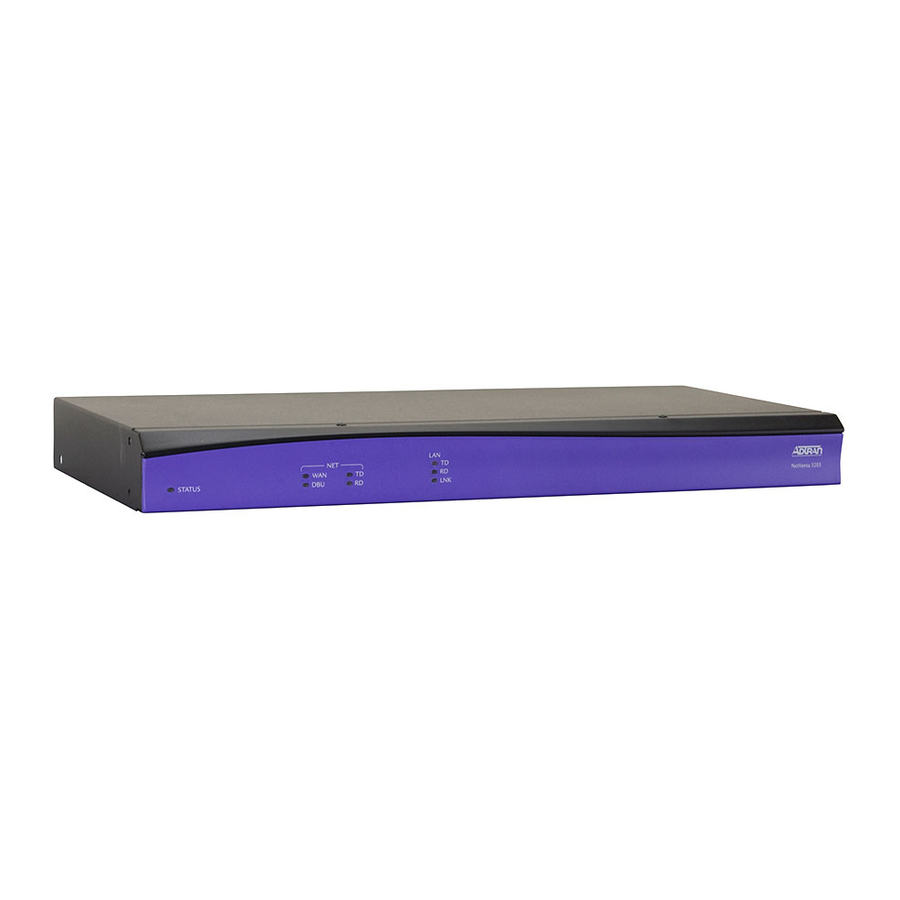
Advertisement
Quick Links
NetVanta
Series
(with E1/FE1 or E1/FE1 with G.703 Drop Network Interface Module)
Quick Configuration Guide
Equipment Required
•
Category 5 - UTP cable for connecting the system to the existing network.
•
VT100 terminal or PC with VT100 emulation software.
•
DB-9 (male) to DB-9 (female) straight-through cable for configuring the unit.
This quick start guide provides step-by-step instructions for configuring your application. The
configuration scripts are available on the ADTRAN OS System Documentation CD.
The configuration parameters used in the example outlined in this document are for
instructional purposes only. Please replace all underlined entries (example) with your specific
parameters to configure your application
Network Diagrams
Frame-Relay Diagram
Branch Office
eth 0/1
LAN IP: 10.10.20.7/24
PPP over Fractional E1 Connection Diagram
Branch Office
eth 0/1
LAN IP: 10.10.20.7/24
64200868L1-42A
PBX
e1 1/2
e1 1/1
NetVanta 3200
PWR
PWR
VPN
VPN
WAN
WAN
LAN
LAN
STAT
STAT
TD
TD
RD
RD
TD
TD
RD
TD
RD
RD
Timeslots 1-15 Data,
NetVanta
Timeslots 17-31 Voice*
FR 1
DLCI 16
Annex D Signaling
192.168.72.1/30
PBX
e1 1/2
e1 1/1
Point-to-Point E1
NetVanta 3200
VPN
VPN
WAN
WAN
LAN
LAN
PWR
PWR
STAT
STAT
TD
TD
RD
RD
TD
TD
RD
TD
RD
RD
Timeslots 1-15 Data,
NetVanta
Timeslots 17-31 Voice*
PPP 1
PPP Signaling
192.168.72.1/30
Technical Support +1-256-963-8716
Corporate HQ
LAN IP:
10.10.10.1/24
WAN IP: 192.168.72.2/30
* Voice circuits require timeslot 16 for signaling. If
voice is required on the e1 1/2 G.703 port, the largest
data map which can be configured is timeslots 1-15
(leaving 17-31 for voice) or 17-31 (leaving 1-15 for
voice).
Corporate HQ
LAN IP: 10.10.10.1/24
WAN IP: 192.168.72.2/30
* Voice circuits require timeslot 16 for signaling. If
voice is required on the e1 1/2 G.703 port, the largest
data map which can be configured is timeslots 1-15
(leaving 17-31 for voice) or 17-31 (leaving 1-15 for
voice).
February 2004
Advertisement

Summary of Contents for ADTRAN NetVanta Series
- Page 1 DB-9 (male) to DB-9 (female) straight-through cable for configuring the unit. This quick start guide provides step-by-step instructions for configuring your application. The configuration scripts are available on the ADTRAN OS System Documentation CD. The configuration parameters used in the example outlined in this document are for instructional purposes only.
- Page 2 Configuring the Unit The NetVanta may be initially accessed and managed either via a console session or through a Telnet session. See step 1a for console session instructions. Initiating a Tel- net session requires using a hub and two Ethernet cables (one for the PC and one for the unit).
- Page 3 NetVanta. You must change the IP address of your PC before you can proceed. ADTRAN recommends that you set the Ethernet speed and duplex to match the switch or hub it is plugged in to. For example: (config-eth 0/1)#speed 10 (config-eth 0/1)#half-duplex 3.
- Page 4 Creating the E1 Interface TDM Group The following steps demonstrate configuring an E1 network interface with timeslots 1- 15 for data. 1. At the (config-e1 1/1)# prompt, enter framing crc4 . 2. Enter sa4tx-bit 0 . 3. Enter tdm-group 1 timeslots 1-15 speed 64 to create a TDM group for timeslots 1- 15 (the data timeslots) on the E1 network connection (e1 1/1).
- Page 5 Configuring the Frame-Relay Virtual Interface The following steps outline configuring a frame-relay virtual interface (labeled 1) using a single DLCI back to the corporate router (defined as DLCI 16). 1. At the (config)# prompt, enter interface fr 1 to create a frame-relay virtual interface labeled 1.
- Page 6 Creating the Cross-Connect 1. For frame-relay applications, at the (config)# prompt, enter cross-connect 1 e1 1/1 1 frame-relay 1 to connect the e1 network connection (e1 1/1) to the virtual frame- relay interface (fr 1.16). 2. For PPP applications, enter cross-connect 1 e1 1/1 1 ppp 1 to connect the e1 network connection (e1 1/1) to the virtual PPP interface (ppp 1).
- Page 7 Configuring Telnet The following steps show how to access the Telnet configuration parameters and change the password. The default password for initializing a Telnet session is password (all lower-case). For security purposes, change the password to something unique. For this example, replace the underlined word with a password of your choosing.








Need help?
Do you have a question about the NetVanta Series and is the answer not in the manual?
Questions and answers